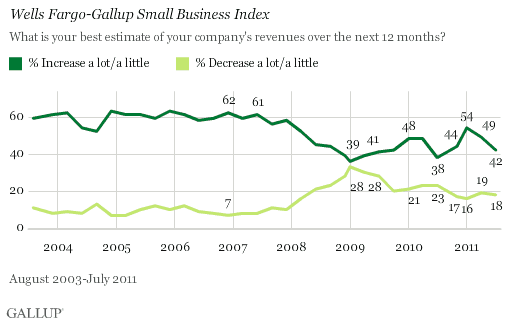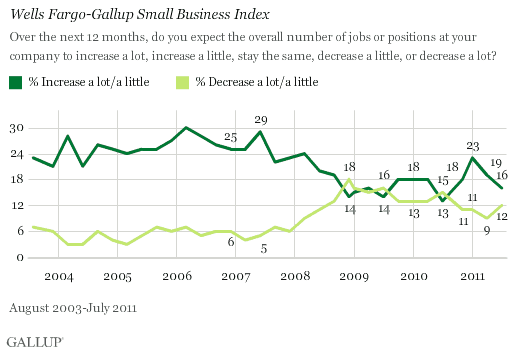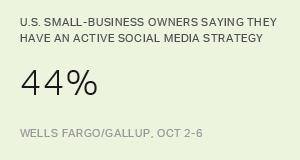PRINCETON, NJ -- Small-business owners turned less optimistic about future revenues and new hiring even prior to the events of recent weeks and the plunge in economic confidence. The percentage of owners anticipating that their revenues would increase over the next 12 months fell to 42% in July, down from 49% in April and 54% in January. At the same time, 18% expect their revenues to decrease. Small-business-owner revenue expectations are no better now than they were in October 2010.

The percentage of small-business owners expecting the overall number of jobs at their company to increase over the next 12 months also fell in July, to 16% from 19% in April and 23% in January. Simultaneously, 12% of owners expect a decrease in the number of jobs at their companies over the next 12 months. Small-business hiring and firing intentions are now the lowest since this time a year ago.

Small Business Owners Remained Neutral on the Economy in July
The Wells Fargo-Gallup Small Business Index was zero in July. This suggests that small-business owners continue to be essentially neutral on the U.S. economy. They are no more optimistic now than they were in April, before events that have driven economic confidence -- and presumably, small-business-owner confidence -- considerably lower during recent weeks.

April's and July's similar optimism levels are consistent with Gallup's Economic Confidence Index, which shows consumer confidence down in April and rising in May before falling back in June and early July.
The Wells Fargo-Gallup Index consists of small-business-owners' ratings of the present situation and their expectations for the future. In July, assessments of the present situation improved, to -10 from -14, as a result of modest improvements in small-business owners' assessments of their cash flows, hiring, and their companies' financial situations.
These improvements in present situation evaluations were offset by a similarly slight decline in optimism about the next 12 months, to +10 from +14. This is mostly because of concerns over revenues and cash flows, resulting in reduced hiring intentions and capital spending.
The Small Business Index tends to be a precursor of future economy activity. It peaked at the end of 2006 and matched that peak in June 2007, prior to the beginning of the recession late that year. The index consistently declined through 2008 and into mid-2009, the time when economists declared the recession officially over. It improved modestly thereafter as the economy recovered more slowly than anticipated, before slipping to a new low in July 2010. The Index recovered significantly after that, turning positive in January 2011, but has slipped to neutral over the past two quarters.
Implications
The July decline in small-business-owner expectations for revenues and cash flows from April is consistent with recent declines in Gallup's Economic Confidence Index. The sharp drop in consumer confidence throughout July and early August can only add to the uncertainty facing today's small-business owners.
Even before the events of recent weeks, small-business owners reported they were pulling back on their hiring intentions for the next 12 months. This is consistent with Gallup's unemployment and underemployment measures that suggest no improvement from a year ago. Given the lack of business revenue and cash-flow visibility today, these hiring expectations may well worsen in the months ahead.
It is essential for policymakers to focus on increasing small-business-owner revenue and cash-flow expectations if the U.S. economy is going to not only avoid recession but begin growing significantly. The latest report of the Federal Open Market Committee suggesting the economy will remain weak for the next couple of years does not seem encouraging in this regard. While the FOMC's intention to keep interest rates low during that time can help with operating costs, it is much less likely to stimulate much-needed consumer spending and generate new hiring.
Survey Methods
Results for the total dataset are based on telephone interviews with 604 small-business owners, conducted July 6-12, 2011. For results based on the total sample of small-business owners, one can say with 95% confidence that the maximum margin of sampling error is ±4 percentage points.
Sampling is done on an RDD basis using D&B sampling of small businesses having $20 million or less of sales or revenues. The data is weighted to be representative of U.S. small businesses within this size range nationwide.
In addition to sampling error, question wording and practical difficulties in conducting surveys can introduce error or bias into the findings of public opinion polls.
For more details on Gallup's polling methodology, visit www.gallup.com.
